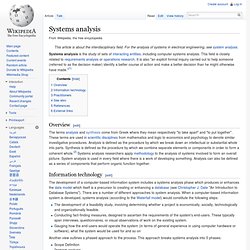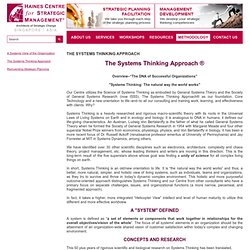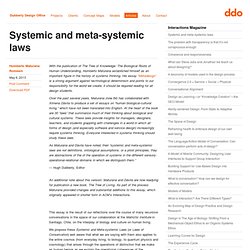

Systems analysis. Systems analysis is the study of sets of interacting entities, including computer systems analysis.

This field is closely related to requirements analysis or operations research. It is also "an explicit formal inquiry carried out to help someone (referred to as the decision maker) identify a better course of action and make a better decision than he might otherwise have made. "[1] Overview[edit] The terms analysis and synthesis come from Greek where they mean respectively "to take apart" and "to put together". Information technology[edit] The development of a computer-based information system includes a systems analysis phase which produces or enhances the data model which itself is a precursor to creating or enhancing a database (see Christopher J.
Another view outlines a phased approach to the process. Scope DefinitionProblem analysisRequirements analysisLogical designDecision analysis Practitioners[edit] See also[edit] References[edit] External links[edit] Top 10 Sites about System Thinking. Systems Thinking and Strategic Thinking. Systems thinking. Systems Thinking. Systems Thinking usage survey 2013 results. Background In August 2010 Ilia Bider posted the following question on LinkedIn; “If System Thinking is such a good method (especially for solving poorly defined problems), why it is not that widespread?”

Similar questions have been raised several times in the Systems Thinking World group on LinkedIn. In an attempt to move from talking in circles on this topic I developed a survey to get some data that could be used to analyse why Systems Thinking (ST) is not more widespread. Summary of results The table below shows the most common answers to the questions of why respondents were not learning more about ST and why they were not using ST more than they already were. Systems-thinking-skills-Large.jpg (Image JPEG, 1200x731 pixels) - Redimensionnée (92%) Why I don’t agree that systems thinking is a ‘fallacy’ It’s been some time since I wrote my counterpoint to Bojan’s article on quitting GTD, and in that time I’ve come to know him a great deal better, to respect his opinion, and I consider him a friend.

However when I read his latest post on the fallacy of systems thinkers I felt compelled to lay out the things I disagree with, and to defend what I see as my position as one of the ‘systems thinkers’ he refers to. Here’s the case for the defence: Exhibit A: The Review process ‘doesn’t work’ Bojan says that for the ‘majority’ of people, the review part of productivity systems is a ‘complete disaster’. He cites the Weekly Review, and says that ‘habits are formed daily, not weekly.’
Whilst it’s hard to dispute that many people (including me) find the review aspect of GTD tough, I think it’s worth considering two points: Fallacy of systems thinking and reversing the productivity game. The problem with productivity enthusiasts these days, is that they will pay more attention to the hacks and tricks, than doing the actual work.

We’ve created this “work masturbation” environment, where doing it better is more important than doing it at all. The problem lies with the saturation of the marketers in the field. They are creating all these artificial needs, like systems, and gadgets, in order to sustain themselves and their continuous work. There is always that new thing, like: setting up your system on iOS, setting up your system within XYZ New Wave application that everybody seems to recommend….
First you need wake up to the truth… …that system is irrelevant. You are justifying your procrastination by doing what has perceived notion of urgency, instead of doing what is important. The habit of mindfulness and it’s impact on productivity. Patrick Woessner's Presentations - Introduction to Systems Thinking. Systems Thinking World - SystemsWiki.
Isee systems - The World Leader in Systems Thinking Software. The Systems Thinker Newsletter. Systems Thinking Press - Strategic & Systems Thinking, Human Resources, Change, Leadership, Planning. Part One: Systems Thinking, A Welcome Disruption to Digital Strategy. This series on digital strategy is divided into five pieces. 1.Systems Thinking, A Welcome Disruption to Digital Strategy 2.Why and How Digital Strategy Typically Fails 3.How You Create the Right Change 4.Governance and Cyclical Improvement are the Secrets 5.Prolonging the Success of Your Hard-Fought Change Part 1.Systems Thinking: A Welcome Disruption to Digital Strategy I believe digital strategists can stand to learn something from “systems thinking.”

Systems thinking is the process of understanding how things influence one another within a whole. It’s about reducing and combining elements and looking under the hood. With that, I see digital strategy as being about understanding how Web, content, technology, social media, mobile and other form factors, internal resources, company culture, enterprise priorities, etc. can influence each other toward a measureable end. Strategy creation is typically a linear process.We know goals influence the research. Strategic System 1. 1. 2. 3. 4. 5. Thinking Page: better thinking using systems thinking, creativity, cybernetics, cognition research. Global Association for Systems Thinking. 11 Laws of Systems Thinking and Stakeholder Engagement. Systems Thinking Graphic from www.systemswiki.org In a previous post we introduced the idea of systems thinking as a way of looking at the world and defined different types of systems.

This post uses Peter Senge’s 11 Laws of the Fifth Discipline to expand on how complex systems work and more importantly looks at how stakeholder engagement can reduce the unintended consequences that plague many of our most well intended decisions. The laws of social systems 1. Today’s problems come from yesterday’s solutions. Systems Archetype – Fixes that fail Oh, we do love to solve problems, lay that last puzzle piece, get the decision made and get on with the work. 2. This is, in systems thinking parlance ”compensating feedback” . … a living system forms from shared interests, all change results from a change in meaning, every living system is free to choose whether it changes and, systems contain their own solutions. 3. 4.
Don’t try this at home! Hammer anyone? 5. 6. Thesystemsthinkingreview. The Systems Thinking Approach - Methodology - Haines Centre for Strategic Management. The Systems Thinking Approach ® Overview–“The DNA of Successful Organizations” "Systems Thinking: The natural way the world works" Our Centre utilizes the Science of Systems Thinking as embodied by General Systems Theory and the Society of General Systems Research (now ISSS).

The Systems Thinking Approach® as our foundation, Core Technology and a new orientation to life–and–to all our consulting and training work, learning, and effectiveness with clients. Systemspraxis.org. Systems Thinking. Systems philosophy. Systems Philosophy is a discipline aimed at constructing a new philosophy (in the sense of worldview) by using systems concepts.

The discipline was founded by Ervin Laszlo in 1972 with his book Introduction to Systems Philosophy: Toward a New Paradigm of Contemporary Thought.[1] It has been described as the "reorientation of thought and world view ensuing from the introduction of "systems" as a new scientific paradigm".[2] Overview[edit] Soon after Laszlo founded Systems Philosophy it was placed in context by Ludwig von Bertalanffy, one of the founders of General System Theory, when he categorized three domains within the Systemics namely: Systems Philosophy consists of four main areas: The term "Systems Philosophy" is often used as a convenient shorthand to refer to "the philosophy of systems" (e.g. here), but this usage can be misleading.
Systems Philosophy. The Systems Thinker Newsletter. Systemic and meta-systemic laws. With the publication of The Tree of Knowledge: The Biological Roots of Human Understanding, Humberto Maturana established himself as an important figure in the history of systems thinking.

His essay “Metadesign” is a strong argument against technological determinism and points to our responsibility for the world we create; it should be required reading for all design students. Over the past several years, Maturana (now 84) has collaborated with Ximena Dávila to produce a set of essays on “human biological-cultural living,” which have not been translated into English. At the heart of the book are 30 “laws” that summarize much of their thinking about biological and cultural systems. These laws provide insights for managers, designers, teachers, and students grappling with challenges in a world in which all forms of design (and especially software and service design) increasingly require systems thinking. Systems thinking. Impression of systems thinking about society[1] A system is composed of interrelated parts or components (structures) that cooperate in processes (behavior).

Natural systems include biological entities, ocean currents, the climate, the solar system and ecosystems. The Fifth Discipline. The Fifth Discipline: The Art and Practice of the Learning Organization (Senge 1990) is a book by Peter Senge (a senior lecturer at MIT) focusing on group problem solving using the systems thinking method in order to convert companies into learning organizations. The five disciplines represent approaches (theories and methods) for developing three core learning capabilities: fostering aspiration, developing reflective conversation, and understanding complexity. Portal:Systems science.
Edit The Systems science Portal Systems are sets of entities, physical or abstract, comprising a whole where each component interacts with or is related to at least one other component and they all serve a common objective.